Love, determination and risking all to cross the Mediterranean
Sadia’s journey from Benin to Europe would see her brave a deadly migration route, and be separated from her husband.
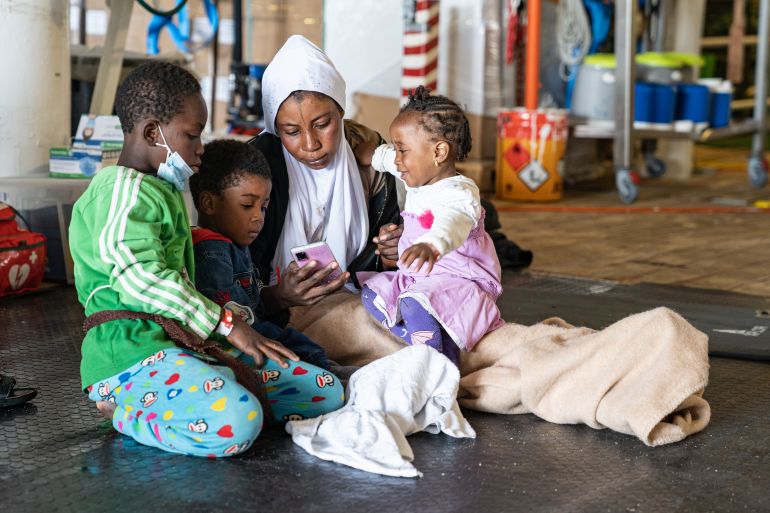
Listen to this story:
It was dark when Sadia*, 25, climbed from the Libyan beach into the little grey inflatable dinghy, together with her three small children, one night in April 2022. As the first to board, they sat at the bow, while the others squeezed in around them. Men straddled the dinghy’s sides, each with one leg dangling in the water.
Keep reading
list of 4 itemsUN report charts lethal cost of migration over past decade
Conflict, climate, corruption drive Southeast Asia people trafficking: UN
Bodies of three Rohingya found as Indonesia ends rescue for capsized boat
Of the 101 passengers, seven were women and 44 were minors, 40 of whom were unaccompanied.
Sadia and her family had travelled from Benin in a bid to reach Europe. However, for this final leg of the journey, she would go alone with her children. She’d had to leave Agidigbi*, her husband – and love – behind.
As the boat headed north, each second putting more distance between her and Agidigbi, Sadia searched in vain for her bag containing water and food. The realisation that it was lost was her last memory on board the dinghy as she succumbed to the waves of nausea and vomiting from severe seasickness, while drifting in and out of consciousness.
Sadia and her children are among the 25,164 irregular sea border crossings registered by Frontex, the European Border Agency, between North Africa and Italy in the first half of this year, 23 percent more than in the first six months of 2021. With the increase in attempts has come a corresponding rise in deaths, according to the United Nations Refugee Agency (UNHCR).
Women make up a very small percentage of people who attempt this dangerous journey. Only 6 percent of the people who arrived in Italy by sea this year were adult women, reported the UNHCR.
Many of these crossings ended in fatalities, including 30 people who went missing in June 2022 from a partially sinking boat in the Mediterranean. A non-governmental search and rescue ship, the Geo Barents, operated by Doctors Without Borders (known by its French initials, MSF) arrived on the scene and was able to rescue 71 people, although a pregnant woman died despite attempts to resuscitate her.
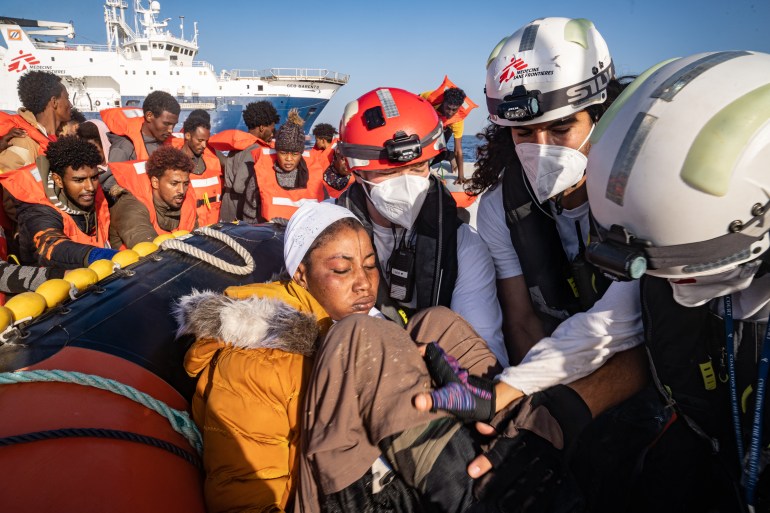
Women, strong and calm
It was common for the smugglers and fellow passengers to direct women and children to sit in the middle of rubber boats or below deck on wooden boats. “This position seems safer from everyone’s perspective. They feel protected by the others surrounding them and less scared to fall in the water,” said Riccardo Gatti, one of MSF’s search and rescue coordinators onboard the Geo Barents.
However, as Gatti explained, this position can ultimately be more dangerous as they are far from a possible escape route, and could get trapped if the crowd panics. “The mix of seawater and fuel, generally running through the middle of the boat can also lead to chemical burns and asphyxiation,” he said.
Female refugees and migrants are often depicted in the media as especially vulnerable, according to Alarm Phone, a non-governmental organisation that relays distress calls from the Mediterranean to emergency services, NGOs and commercial vessels in the area. However, in reality, that is rarely the case.
Distress calls from boats leaving Libya are almost always made by male passengers, said Hela (who asked Al Jazeera not to publish her last name) an activist with Alarm Phone since 2018.
However, in Hela’s opinion, often the person calling is “too stressed” to communicate clearly – as they are travelling hundreds of kilometres in an overcrowded boat – so Alarm Phone staff will ask to speak to a female passenger.
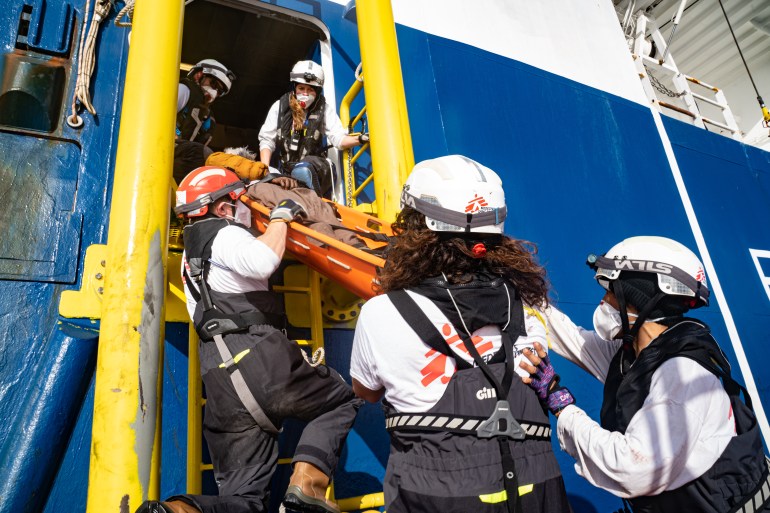
They are “almost always the strongest and the calmest. They are so powerful that they always manage to actually calm down the people, explain the situation and the communication is usually much easier with women,” she said.
A few hours after Sadia’s boat had set off, a man on board placed a distress call to Alarm Phone – using a satellite phone given to him by the smugglers in Libya – that was then relayed to the Geo Barents. Sadia has no recollection of the two MSF rescue boats approaching them on April 23 at 7:45am when they were 37km (23 miles) from the coast of Libya. She doesn’t remember being transferred into a stretcher and heaved up through a door on the side of the multi-decked, 77-metre (253-foot) ship.
Nejma Banks, the Algerian-American cultural mediator onboard the Geo Barents and herself a mother of four, was part of the crew who rescued Sadia. She had seen survivors in that state before. “Travelling on a boat with the fuel smells, the crowd and, you’re prone to seasickness. The sea is merciless,” she said in a moment of calm after the rescue.
Two days later, treated for her seasickness and wearing an MSF-issued tracksuit instead of the wet, fuel-soaked clothes that she was rescued in, Sadia sat on a deck reserved for women and children, gently rocking her one-year-old daughter to sleep. Just a few metres away, her two sons, aged seven and two, played with plastic safari animals.
Banks sat cross-legged on the floor, quietly listening to Sadia’s story of love, determination and friendship in the face of unimaginable horror, occasionally reaching over to touch her wrist to clarify something before turning to translate.
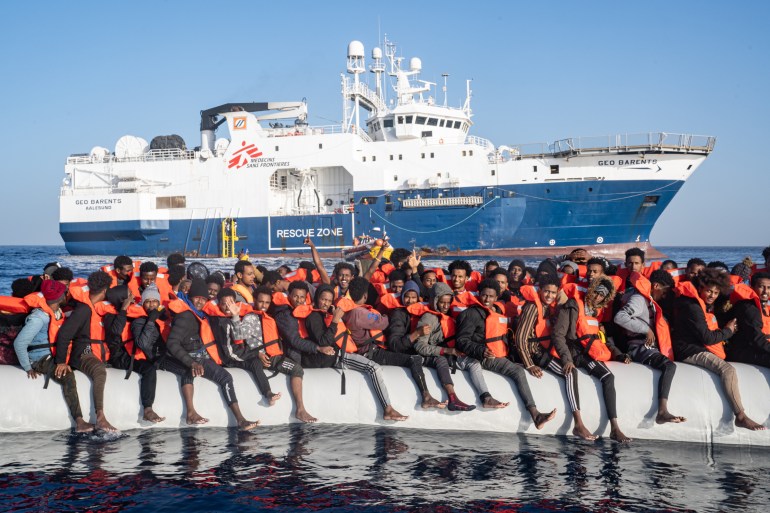
Leaving Burkina Faso
Sadia hasn’t had the luxury of an education, so dates, times and place names are hazy, but her memories are clear.
Approximately a decade ago, she heard gunfire near her village in Burkina Faso. She and her brothers hid, but the gunmen shot her parents and sister in the head and destroyed their village, all of which Sadia saw from her hiding place.
She fled to Benin where she found work preparing food and shortly afterwards met the man who would become her husband and father to her three children.
“It was love at first sight,” she said, with a “very nice man”. She laughed as she said this and a huge smile lit up her face, divided by a striking tribal scar running down the centre of her forehead.
When Sadia’s employer stopped paying her wages, they had to move on. Sadia suggested Burkina Faso but her husband chose Libya. “Where I’m from, men decide,” she said. Despite being aware of how people suffer in Libya, she agreed to go.
Sadia, her husband and their two sons travelled by truck with dozens of others for weeks across the desert, as they made their way north initially to Agadez in Niger and then on to Tripoli via Sabha in Libya. At night, they slept at the side of the road, along with wild animals and poisonous snakes that were camouflaged in the sand.
While acknowledging the “steep rise” in the death toll of those crossing the Mediterranean, UNHCR spokesperson Shabia Mantoo also said that “even greater numbers may have died or gone missing along land routes through the Sahara Desert and remote border areas”.
Sadia herself has seen the dead along the land routes. As they balanced on the back of the truck without food and water, Sadia saw the bodies of those who had fallen. Some “who are very dry and those who have just died [including] a mother with a baby about my daughter’s age in her arms”, she said. She knew their driver would not stop for them if they fell.
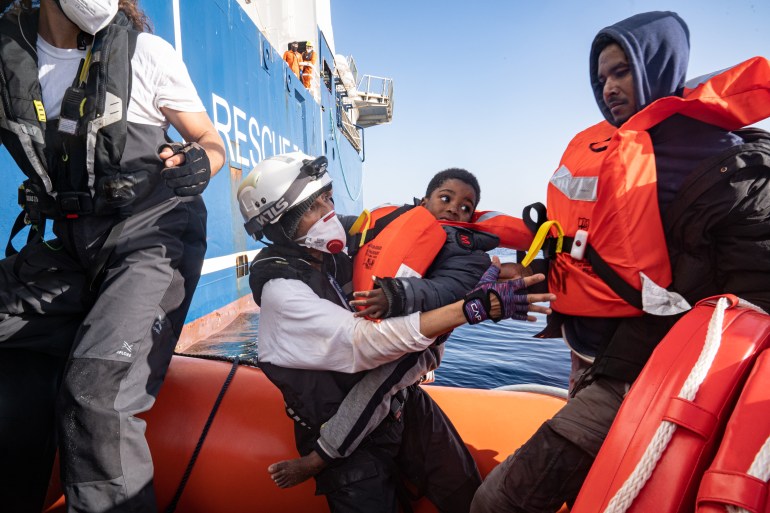
The ‘camps’
When Sadia and her family arrived in Libya, they were held in a room with no windows, no food and no water, detained by three men who demanded money to take them to Europe – money that they didn’t have. They had already paid 1,800,000 West African francs ($2,760) to a smuggler to take them from Benin to Europe, but he had disappeared.
“And that’s when the beatings began,” she said.
Ultimately, after six months, Sadia and her family were thrown out of the camp. They slept on the streets, before finding work for a Libyan family tending to their house and garden and saving to pay another smuggler.
The family’s first attempt to reach Europe did not end well. Their boat leaked, forcing them to return to Libya where waiting authorities caught and detained Agidigbi although Sadia and the children managed to hide. It was two weeks before she received a call from her husband from a detention centre.
“[He] said that you are so squeezed with people that the person seemed to be sleeping but in the morning we found them dead. All of these people were found intercepted in the water and [the guards] asked for money. Some of them find the money, others cannot pay,” she said.
The detention centre demanded 7,000 Libyan dinars ($1,440) for Agidigbi’s freedom, payable through a broker, who ultimately stole their money, forcing Sadia to borrow money from a friend in Libya – whom she met in Niger – and organise the payment through a different person.
Sadia and Agidigby’s experience is alarmingly common, and most of the survivors on board the Geo Barents spoke of similar camps.
“Most of the refugees and migrants returned [by the Libyan Coast Guard] are transferred from disembarkation points into detention centres, held under inhumane conditions without access to due process and humanitarian services,” reported the UN Office for the Coordination of Humanitarian Affairs.
Federico Soda, the Libya chief of mission for the United Nations’ International Organization for Migration (IOM), referred to conditions in official detention as “deplorable” where refugees and migrants are “either extorted or handed back to smugglers and traffickers”.
He said, “There is still no system in place in the country to safely and securely accommodate the most vulnerable, including women and children.”

Staying behind
With her husband free, they paid back the loan and Sadia tried again but this time – at her husband’s suggestion – he would stay behind, as it was cheaper for her to travel alone with the children. Unfortunately, she fared no better, as her boat was intercepted at sea by the Libyan Coast Guard although Sadia was so unwell from seasickness that she was transferred to hospital instead of a detention centre.
This year, 9,430 people have been “rescued or intercepted” by Libyan authorities, according to the UNHCR. Most of those people are then transferred to detention centres.
Sadia escaped detention when she managed to flee the hospital with her children. And so, almost nine months pregnant, she returned to her husband, where shortly afterwards she would give birth in a garden in Zawiya, Libya with no medical support as Agidigby tried to suppress her screams and then cut the cord.
As Sadia talked and Banks translated, Sadia would regularly repeat, “We suffered. I suffered. The children suffered. My husband suffered so much,” while also shaking her head.
But amid the horror, there were moments of kindness. Such as the “Arab man” who brought diapers and food into the camp when she was detained, the woman who lent her the money to free her husband and then – just three weeks after she gave birth – watched her children when Sadia returned to work.
Again they worked for Libyan families, with Sadia doing housework, and again they saved money for her and the children to try a third time. And that was when Sadia was rescued by the Geo Barents, without her husband.

Waiting to disembark
Survivors must wait on board the Geo Barents until they are offered a port of safety by a European government. Although Sadia didn’t know it at the time of the interview, she would be on board for another week, sleeping on a thin plastic mat under a scratchy brown blanket, with no access to internet or mobile phone signal, before she would be allowed to disembark in Augusta, Sicily, on May 2.
“I’m worried about my husband. What is he thinking? Did we drown? Were we intercepted? I cannot call from here,” said Sadia with a sad, resigned look.
I asked what she would like to say to him. She laughed a soft, warm laugh, as a huge smile transformed her face. “Too many things I want to tell him. He helped our children and me so much. We suffered so much, he could have abandoned me with the kids, but he didn’t,” she said. “He is a good man. He is the one who gives me courage to continue.”
Listening to the end of Sadia’s story, Banks was bathed in light from an opening in the partially drawn, canvas curtain at the aft (back) of the ship. Banks too smiled as she finished translating. “You can feel the love,” she said. “Her whole face brightens up. She is so in love with him.”
*Names have been changed to protect identities